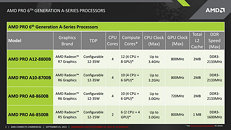Wednesday, October 7th 2015

AMD Pro A12 "Carrizo" Chip Offers TDP as Low as 12W
AMD's "Excavator" module could fetch big power dividends for the company, with the top of the line Pro A12 "Carrizo" APU for mobile platforms offering TDP as low as 12W (normal usage), going up to 35W (maximum stress). AMD allows users to set the TDP for their processors. Built on the existing 28 nm process, these chips offer TDPs as low as the ones offered by Intel, built on 22 nm and even 14 nm nodes.
This is made possible because "Excavator" features heavily compacted registers and decode engines, and AMD spent a lot of R&D kicking out redundant or useless components from the silicon. The recently launched A-Series Pro "Carrizo" APUs feature two "Excavator" modules (four CPU cores), a GPU with eight GCN 1.2 compute units (512 stream processors), 2 MB of total cache, dual-channel DDR3-2133 integrated memory controllers.
This is made possible because "Excavator" features heavily compacted registers and decode engines, and AMD spent a lot of R&D kicking out redundant or useless components from the silicon. The recently launched A-Series Pro "Carrizo" APUs feature two "Excavator" modules (four CPU cores), a GPU with eight GCN 1.2 compute units (512 stream processors), 2 MB of total cache, dual-channel DDR3-2133 integrated memory controllers.

39 Comments on AMD Pro A12 "Carrizo" Chip Offers TDP as Low as 12W
Sigh.
I'm guessing the A12 + 1080p/1440p + SSD is going to be in the i7 (HP) or i7 + discrete graphics (anyone else) price bracket
Dell's Six New Precision Workstations
But I am not in laptops, definately no idea about business systems, so I could be completely wrong. I do find HP's prices on their AMD power laptops to favor.... Intel.
As for Carrizo, I would say that it is pretty late and the biggest problem I am reading is that in the very few laptops that are out there the manufacturers limit the chip at 15W TDP which means 30% lower performance than what it can do.
if this can handle a decent game settings at fluid 720p maybe it will make a decent htpc/"living room" computer (stream, light gaming, fb machine, lolcat browser) other than that its kinda "meh"
Judging AMD's past with integrated graphics, this little Carrizo should definitely be able to handle 1080p for HTPC users. Now imagine if this was also equipped with some HBM memory and 14/16nm process, I'm thinking these could make it into next generations ultrabooks/tablets. That's the market where AMD needs to undeniably penetrate.
cpuboss.com/cpus/Intel-Core-M-5Y10-vs-AMD-FX-7600P
Hyper threading equivalent is just how AMD initially tried to market the unusual architecture.To be fair this is for mobile market with power consumption as its focus. They still need products to sell between now and Zen architecture.
I see no evidence that the A12 is on the market yet... the fx chip is the closest thing performance wise and that is why I compared it.
You can keep your core M... I will take the performant chips.
Oh and since you can't apparently search.
www.notebookcheck.net/AMD-FX-8800P-Notebook-Processor-Specifications-and-Benchmarks.144074.0.html
laptoping.com/cpus/product/amd-fx-8800p/
Look into it a little harder and find the review of the HP running the CPU. I want you to find that for yourself. I would read it after a couple of beers because when forced into a 15w TDP envelope it gets is ass handed to it by the core M. Call it performance or call it junk either way at 12w it is underwhelming.
Sweet.
You are a bit too personally vested in the Core M thing... Should have sprung for the 70, as that is the only one close-ish to an i5 in single threaded. Enjoy your 4.5w c2d.
Don't get me wrong, the fact that they can turbo enough to make single threaded performance bearable at 4.5w is nice... but I need more threads.
Yoga 3 vs yoga 2 shows you how bad core M is.
Marketing wise they would have faired a lot better if they marketed their FX4xxx as dual cores and FX 8xxx as a quad core with a "physical hyper threading" feature and they would have directly competed with the i3 and i5 line up.
Then they should have release a 16 core and marketed it as a 8 core with "physical hyper treading" to compete with the i7.
Had AMD did this it would have rescued the module architecture and would have outperformed its Intel equivalent. The only downside would be the high TDP but that would be forgiven by the enthusiasts if the performance was there.